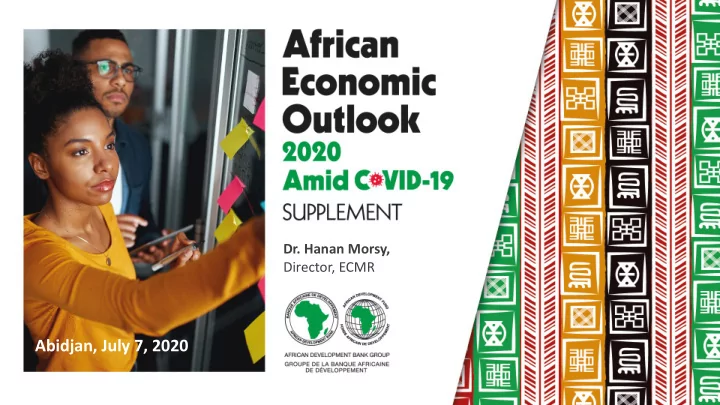

Dr. Hanan Morsy, Director, ECMR Abidjan, July 7, 2020
OUTLINE OF THE MAIN REPORT SECTION 1 MACROECONOMIC PERFORMANCE AND PROSPECTS SECTION 2 SOCIO-ECONOMIC IMPACTS OF COVID – 19 ON AFRICA SECTION 3 POLICY OPTIONS 2
SECTION 1 MACROECONOMIC PERFORMANCE AND PROSPECTS
COVID – 19 HAS REVERSED AFRICA ’ S STRONG GROWTH TRAJECTORY Africa is projected to fall into a recession in 2020 • Under the baseline scenario, real GDP in Africa is projected to contract by 1.7 percent in 2020. • In the worst-case scenario, GDP could fall by – 3.4 percent in 2020. • Partial recovery of about 3 percent is projected for 2021. Source: African Development Bank statistics 4
THE IMPACT OF COVID-19 AND PROSPECTS FOR RECOVERY VARIES ACROSS REGIONS AND ECONOMIES Tourism-dependent economies and oil-exporters would East Africa would be the most resilient, while Southern suffer more losses than non-resource-intensive economies Africa could be the hardest hit in 2020 Source: African Development Bank statistics. 5
MACROECONOMIC FUNDAMENTALS ARE DETERIORATING Currency depreciations have been sharper in frontier economies • Inflation has quickly increased in the continent because of supply chain disruptions — up to 5 pp more in some countries • Exchange rates have fluctuated widely, especially for frontier economies as a result of capital outflows. Source: African Development Bank statistics. 6
FISCAL DEFICITS AND DEBT LEVELS ARE RISING Fiscal deficits are projected to at least double in 2020 … while debt-to-GDP ratios are projected to … increase further by up to 10pp Source: African Development Bank statistics. 7
EXTERNAL POSITIONS ARE EXPECTED TO WORSEN SIGNIFICANTLY DURING THE CRISIS Foreign direct investment and remittances flows will be Africa ’ s current account is expected to disrupted worsen to 8.1 percent of GDP in 2020 8 Source: African Development Bank statistics.
SECTION 2 SOCIO-ECONOMIC IMPACTS OF COVID – 19 ON AFRICA
ALTHOUGH COVID-19 ARRIVED IN AFRICA RELATIVELY LATE, ALL 54 COUNTRIES ARE NOW AFFECTED The curve of the pandemic in Africa is bending gradually • With over 400,000 reported cases and 10,000 reported deaths as of June 29, 2020, Africa has been the least affected continent. • The curve of the pandemic is bending gradually in Africa, but hotspots are present in South Africa, Egypt, Nigeria, and Algeria. 10 Source: Johns Hopkins University COVID – 19 database.
AFRICA IS INADEQUATELY PREPARED TO CONTAIN THE PANDEMIC Health system preparedness for epidemic threats varies significantly, with 33 countries rated as least prepared 11 Source: Global Health Security (GHS) Index.
COVID – 19 HAS REVERSED THE GAINS IN MEETING SDG TARGETS FOR POVERTY AND EMPLOYMENT Between 28.2 and 49.2 million people to fall into extreme poverty • Extreme poverty is projected to increase by 2.14-2.84 pp in 2020 and by 2.51-3.63 pp in 2021. COVID-19 could push 49 million into extreme poverty. • An estimated 25 to 30 million jobs could be lost as a result of the economic fallout caused by COVID-19. Sources: Staff computations using World Bank ’ s PovcalNet datasets, growth projections by African Development Bank 12 Statistics Department, and population growth by United Nations Population Division.
AFRICA ’ S YOUNGER DEMOGRAPHIC STRUCTURE COULD BE HELPING TO MITIGATE THE HEALTH IMPACTS OF COVID – 19 Fatality rates are higher for countries with large … and lower for those with large shares of younger shares of older people … people, as in Africa Sources: Staff computations using data from the World Health Organization and UN- 13 DESA. 19 April 2020
SECTION 3 POLICY OPTIONS SECTION 3 POLICY OPTIONS
MAIN POLICY RECOMMENDATIONS Public health responses : • Develop effective information sharing and communication strategies. • Allocate sufficient resources to the health sector and develop emergency plans. Fiscal policy responses : • Support vulnerable households with targeted cash transfers and social safety net programs. • Help businesses stay afloat by providing targeted subsidies and tax reliefs. Monetary policy responses : • Ease financial conditions by injecting liquidity. • Use unconventional policy tools to support affected sectors. Labour market and informal sector responses : • Assist vulnerable groups, especially women and youth in informality. • Use active labour market policies to protect workers and their jobs. 15
STRATEGIES FOR REOPENING ECONOMIES AND ACCELERATING RECOVERY The “ zero tolerance ” approach: • Governments would refrain from reopening economic and social activity until there are zero or no reported new cases of the infection. This is likely to take longer and have unbearable costs. The “ staggered ” approach: • Governments would reopen economic and social activity in a phased and incremental manner on the basis of transmission risks. • Businesses with low-to-medium transmission risks such as manufacturing, construction and some retail services can be reopened first. • If there are no rebounds, proceed to open high transmission risk activities such as hotels, schools, restaurants, sports, and entertainment . 16
THANK YOU
Recommend
More recommend